
(Click on any image below for a larger version)
Thursday, January 25: Livingstone Island
The sun came out every once in a while as we cruised to Livingstone Island, but most of the time it was overcast. I put on extra layers of clothes and my hooded parka and went up to the observation deck.
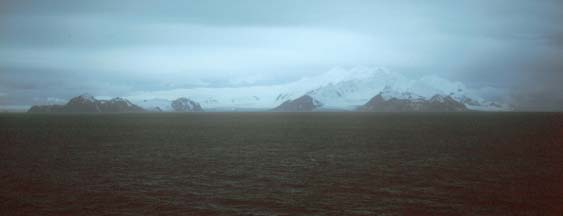 Glaciers
cover most of Livingstone Island. Only the headlands near the
shore are free of ice. The part of the island that we could see
was composed largely of dark, old metamorphic rocks from the
Paleozoic Era.
Glaciers
cover most of Livingstone Island. Only the headlands near the
shore are free of ice. The part of the island that we could see
was composed largely of dark, old metamorphic rocks from the
Paleozoic Era.
The sea was flat with a light chop as we cruised toward the island. I had been sitting in a deck chair, shielded from the wind by the metal barrier at the front of the observation deck for over an hour, dozing off part of the time, when I spotted a whale spout about a mile off the port bow.
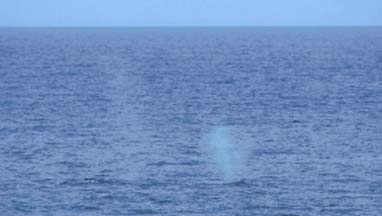 Within
a few moments more whales spouted in the same area. It was a pod
of about a half-dozen Humpback Whales. The pod passed about a
quarter of a mile to the port side of the ship. They would stay
submerged for the better part of a minute, then they would
surface and we would see a dozen spouts in as many seconds. We
could clearly see their dorsal fins.
Within
a few moments more whales spouted in the same area. It was a pod
of about a half-dozen Humpback Whales. The pod passed about a
quarter of a mile to the port side of the ship. They would stay
submerged for the better part of a minute, then they would
surface and we would see a dozen spouts in as many seconds. We
could clearly see their dorsal fins.
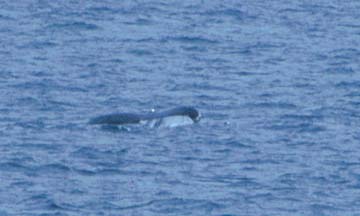 Several
times we saw the flukes of the whales as they sounded.
Several
times we saw the flukes of the whales as they sounded.
The force of the wind increased as we got closer to the island. A very cold wind was blowing down from the glacier in front of us. The wind speed was about fifty miles per hour, producing a severe wind chill.
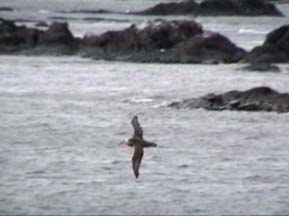 Southern Giant Petrels seemed to
relish the high wind. They glided in front of the Hanseatic,
turning left and right to stay in the region of lift produced by
the wind rising over the ship.
Southern Giant Petrels seemed to
relish the high wind. They glided in front of the Hanseatic,
turning left and right to stay in the region of lift produced by
the wind rising over the ship.
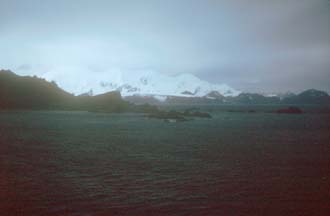 The ship sailed close by Hannah
Point, a low, rocky headland, and dropped anchor in the bay.
Large chunks of ice littered the shore of the bay.
The ship sailed close by Hannah
Point, a low, rocky headland, and dropped anchor in the bay.
Large chunks of ice littered the shore of the bay.
I was placed at the front of the Zodiac for the ride to shore. I recognized our Zodiac driver as Sandy, the girl who waited on our usual table in the Marco Polo Restaurant. She was being evaluated for her Zodiac rating.
The wind was still blowing hard, kicking up some chop and tearing spray off the tops of the waves as we rode to the shore. Every so often, the bow of the Zodiac would smack into a wave and splash a generous quantity of 33 degree F. water up over the bow and into my face. A shoal of ice chunks, each piece a few feet across, had accumulated in the groin of the point near the Zodiac landing.
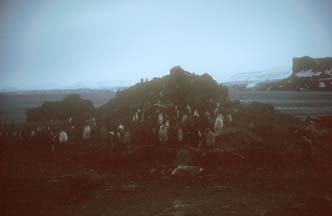 Both Gentoo Penguins and Chinstrap Penguins rook at Hannah Point.
Their colonies are right next to each other, but they do not mix
with each other very much.
Both Gentoo Penguins and Chinstrap Penguins rook at Hannah Point.
Their colonies are right next to each other, but they do not mix
with each other very much.
 Hear the Gentoo and Chinstrap Penguins.
Hear the Gentoo and Chinstrap Penguins.
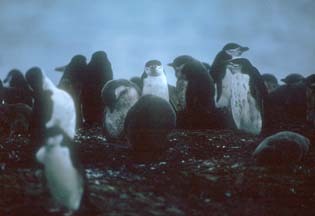 The Chinstrap Penguin rookery was much messier
than the Gentoo Penguin rookery.
The Chinstrap Penguin rookery was much messier
than the Gentoo Penguin rookery.
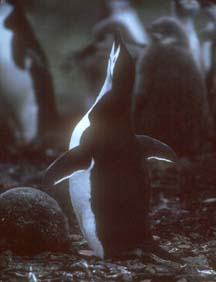 Chinstrap Penguins advertised their availability for mating by
flapping their wings and singing at the sky.
Chinstrap Penguins advertised their availability for mating by
flapping their wings and singing at the sky.
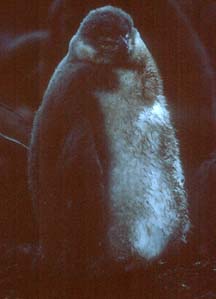 The Chinstrap Penguin Chicks accumulated a
coating of guano as they sat around the rookery waiting for their
parents to return from feeding at sea.
The Chinstrap Penguin Chicks accumulated a
coating of guano as they sat around the rookery waiting for their
parents to return from feeding at sea.
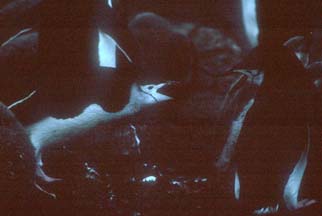 There were occasional disagreements over
territory between the adult penguins.
There were occasional disagreements over
territory between the adult penguins.
White Sheathbills strutted among the penguins, looking for fresh guano to dine upon. Near the top of the rookery a gray and white, adult Kelp Gull was nesting with a spotted gray fledgling.
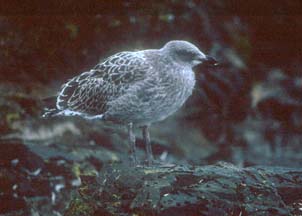 A
drop of salt water from the salt excreting organ near the
fledgling's nostrils was hanging from the tip of its beak.
A
drop of salt water from the salt excreting organ near the
fledgling's nostrils was hanging from the tip of its beak.
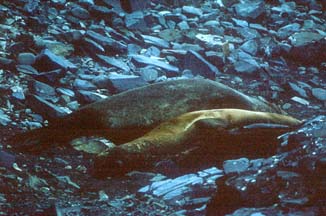 A short hike brought me to the top of the cliff
overlooking the other side of the point. Southern Elephant Seals
were basking on the rocky shore below. Most of them were adult
females. There were a few juveniles of both sexes as well. One of
the adult females wallowed across the rocks and into the water.
People often compare the motion to a big slug, but to me it looks
more like a big, fat, fast-moving inchworm.
A short hike brought me to the top of the cliff
overlooking the other side of the point. Southern Elephant Seals
were basking on the rocky shore below. Most of them were adult
females. There were a few juveniles of both sexes as well. One of
the adult females wallowed across the rocks and into the water.
People often compare the motion to a big slug, but to me it looks
more like a big, fat, fast-moving inchworm.
Penguins entered the water in small groups. They waddled a short distance into the water and flopped onto their bellies. They paddled for a short distance, looking around for Leopard Seals, before ducking their heads under the water and swimming off. They accelerated remarkably fast once they were flying submerged. They left sharp, v-shaped wakes in the water behind them as they porpoised along.
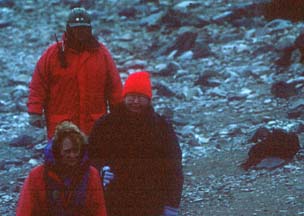 Debbie looked around for another kind of penguin to videotape.
Debbie looked around for another kind of penguin to videotape.
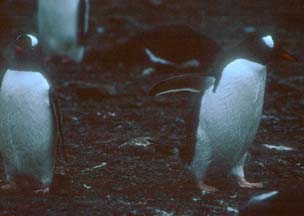 The Gentoo Penguins generally maintained a larger personal space
than the Chinstrap Penguins.
The Gentoo Penguins generally maintained a larger personal space
than the Chinstrap Penguins.
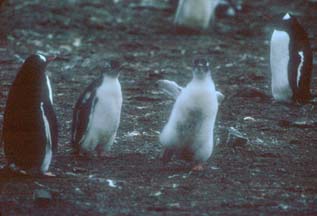 Feeding chases were happening all over the
rookeries. Pairs of fat, gray and white, down-covered Gentoo
Penguin chicks chased slender black and white adults in order to
get their ration of krill. The chicks were fatter than the adult
penguins and they were nearly as tall. The Gentoo Penguin chicks
had less guano embedded in their down than the Chinstrap Penguin
chicks.
Feeding chases were happening all over the
rookeries. Pairs of fat, gray and white, down-covered Gentoo
Penguin chicks chased slender black and white adults in order to
get their ration of krill. The chicks were fatter than the adult
penguins and they were nearly as tall. The Gentoo Penguin chicks
had less guano embedded in their down than the Chinstrap Penguin
chicks.
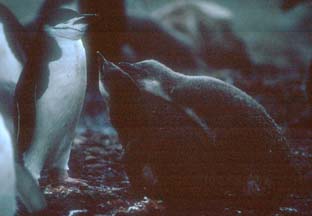 The pairs of chicks begged the adult penguins
to cough up some lunch.
The pairs of chicks begged the adult penguins
to cough up some lunch.
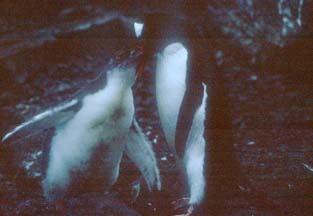 A Gentoo Penguin parent regurgitated another
meal of krill into its chick's mouth.
A Gentoo Penguin parent regurgitated another
meal of krill into its chick's mouth.
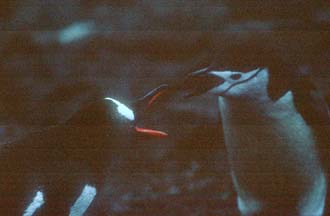 A Chinstrap Penguin and a Gentoo
Penguin encountered each other at the boundary between the
rookeries.
A Chinstrap Penguin and a Gentoo
Penguin encountered each other at the boundary between the
rookeries.
We rode a Zodiac to another landing on the far side of the bay. This time I made sure that the hood of my parka was not caught in my lifejacket and camera bag strap, so I could protect myself better from the cold spray.
We landed on a broad beach of black sand. The high tide line was dotted with strangely sculpted pieces of ice that were coated with a thick layer of the black sand.
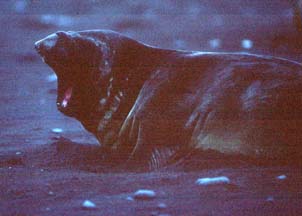 We were directed toward a group of Southern
Elephant Seals lying a short distance down the beach.
We were directed toward a group of Southern
Elephant Seals lying a short distance down the beach.
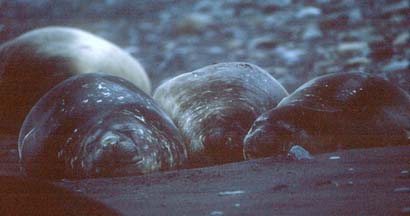 They slept quietly for the most part. Once in a
while one of them would scratch an itch with its pectoral fin.
They slept quietly for the most part. Once in a
while one of them would scratch an itch with its pectoral fin.
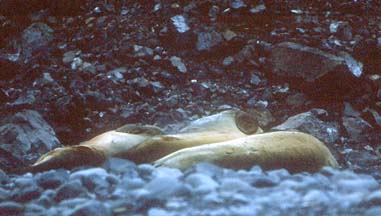 A trio of juvenile seals was lying on the
cobbles above the beach. They were lighter in color than the
adult seals.
A trio of juvenile seals was lying on the
cobbles above the beach. They were lighter in color than the
adult seals.
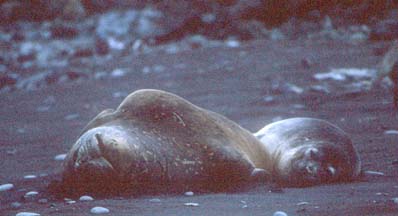 There were a couple of extremely large males
lying amongst the smaller, yet still very big, females. Male
Southern Elephant Seals do not have the trunk-like proboscis of
the Northern Elephant Seal.
There were a couple of extremely large males
lying amongst the smaller, yet still very big, females. Male
Southern Elephant Seals do not have the trunk-like proboscis of
the Northern Elephant Seal.
The beach was obstructed by a moraine, composed of unsorted, angular stones deposited at the end of a glacier. The glacier had retreated up the slope several hundred feet since the moraine had been deposited. Smaller moraines marked places where the rate of retreat had slowed, so that the position of the foot of the glacier had been fairly stable for a period long enough to dump a load of rocks.
We crossed a stream of glacial melt water, milky with finely ground sediment, and patches of green moss to get to the base of the hills above the beach. Joann Stock of Caltech was standing near some large boulders that had tumbled from the slopes above. She explained the volcanic origin of the boulders and pointed out some of the interesting inclusions in them. It appeared that the hill above us was built of a lava flow that was overlain by pyroclastic flows of volcanic ash. The volcanic eruptions probably dated back to the Paleozoic Era. When it was evident that no other passengers were going to walk over to see the geology, Joann climbed farther up the slope to examine the exposures of bedrock.
A large collection of interesting stones had been placed on one of the boulders. It was evident that the display had been accumulating for many years. The rocks included large pieces of petrified wood and shale bearing the imprint of fern fossils. A variety of bones had been assembled on another boulder nearby. The jaw and teeth of a Leopard Seal were clearly recognizable. There were bits of whale bone as well as bones of other pinnipeds.
The surfaces of the boulders had acquired a woolly growth of lichens and mosses. Some of the lichens grew several inches long.
It was getting late in the afternoon and almost all of the other passengers had returned to the Hanseatic already. We walked back down to the Zodiac landing to wait for the next boat. A solitary Gentoo Penguin patrolled the shore near the landing.
When the Zodiac arrived it was apparent that everyone left on shore would fit aboard, so we all piled into the last boat to return to the Hanseatic from our last landing in Antarctica.
The ship weighed anchor that evening and steered a course around Livingstone Island to reach the Drake Passage.
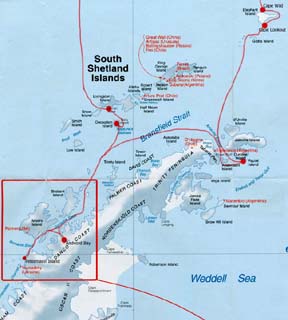 Map of the Antarctic Peninsula.
Map of the Antarctic Peninsula.
 Table of
Contents
Table of
Contents Send a message to Brian.